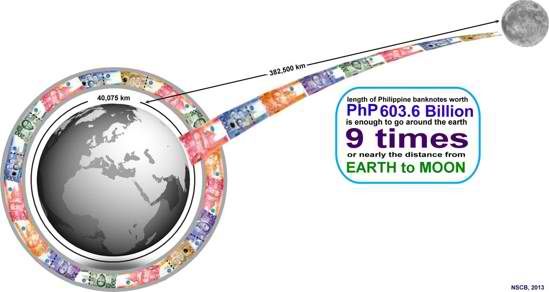
MANILA - How many peso bank notes and coins are there in the Philippines?
According to the National Statistical Coordination Board (NSCB), the combined length of the country's banknotes -- if these were connected end to end -- is enough to go nine times around the earth’s equator or nearly the distance of the earth to the moon.
NSCB Secretary-General Jose Ramon G. Albert said the country had 2.32 billion pieces of notes valued at P603.64 billion as of last June.
Laid down end-to-end, the banknotes would run to more than 371.2 thousand kilometers – equivalent to 100 time the length of the Pan-Philippine National Highway, which extends from Laoag City in Ilocos Norte to Zamboanga City in Mindanao.
There are two sets of banknotes issued by the Bangko Sentral ng Pilipinas (BSP) and in use today: the New Design Series (NDS) and the New Generation Currency (NGC). The NDS has been in use for more than a quarter of a century while the NGC has been in use starting December 2010.
To thwart counterfeiters, the NGC features improved security features which include embossed prints, security fibers, watermark, see-through mark, and others.
The NGC shall eventually replace the NDS once the latter is demonetized. In the meantime, both are legal tender.
Apart from banknotes, the Philippines had 20.08 billion pieces of coins in circulation worth a combined P22.77 billion as of June this year.
More than half or 56.6 percent of these are lower denominated coins. Coins in circulation are the following: one centavo, five centavos, 10 centavos, 25 centavos, one peso, five pesos and 10 pesos.
Citing BSP estimates, Albert said the number of coins is equivalent to 207 pieces of coins per Filipino.
But, is there a shortage of coins?
"Believe it or not, the Philippines does not have a shortage of coins," Albert said.
"The BSP explains that occasionally, there is an artificial shortage of coins due to the habit of people of keeping coins in wallets, drawers and piggy banks instead of using them as payment for goods and services, or depositing them in banks," he said.
In the case of one-peso coins, there is high demand because of the popularity of "coin games," which interfere in the circulation of coins throughout the economy, Albert said.
In the past, the BSP and the Bureau of Customs recorded attempts to smuggle out one-peso coins and in some cases, they are hoarded for melting and export, Albert said.
As per Republic Act No. 7653, otherwise known as the New Central Bank Act, the BSP has the sole power and authority to issue currency within the Philippine territory. The BSP not only issues Philippine peso banknotes and coins for general circulation but also commemorative notes and coins which are legal tender as well.
source: Interaksyon
No comments:
Post a Comment